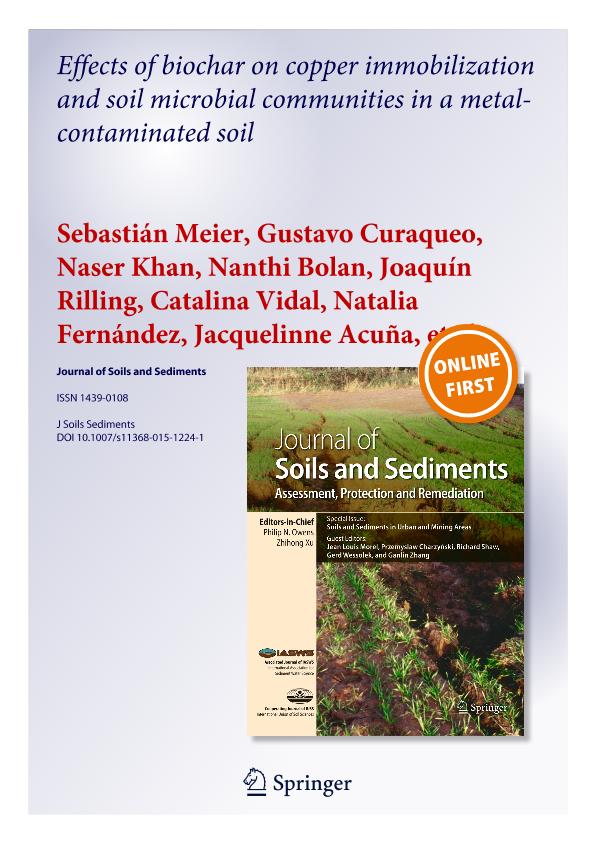Artículo
Effects of biochar on copper immobilization and soil microbial communities in a metal-contaminated soil
Meier, Sebastián; Curaqueo, Gustavo; Khan, Naser; Bolan, Nanthi; Rilling, Joaquín; Vidal, Catalina; Fernández, Natalia Verónica ; Acuña, Jacquelinne; González, María Eugenia
; Acuña, Jacquelinne; González, María Eugenia ; Cornejo, Pablo; Borie, Fernando
; Cornejo, Pablo; Borie, Fernando
 ; Acuña, Jacquelinne; González, María Eugenia
; Acuña, Jacquelinne; González, María Eugenia ; Cornejo, Pablo; Borie, Fernando
; Cornejo, Pablo; Borie, Fernando
Fecha de publicación:
06/2015
Editorial:
Springer Heidelberg
Revista:
Journal Of Soils And Sediments (print)
ISSN:
1439-0108
e-ISSN:
1614-7480
Idioma:
Inglés
Tipo de recurso:
Artículo publicado
Clasificación temática:
Resumen
Purpose: Copper (Cu) contamination has been increasing in land ecosystems. Biochars (BCs) and arbuscular mycorrhizal fungi (AMF) are known to bind metals, and metallophyte can remove metals from soils. Will BC in combination with AMF contain the Cu uptake by a metallophyte growing in a metal-contaminated soil? The objective of this study was to investigate the effects of BCs on the Cu immobilization and over soil microbial communities in a metal-contaminated soil in the presence of AMF and metallophyte.
Materials and methods: Two BCs were produced from chicken manure (CMB) and oat hull (OHB). A Cu-contaminated sandy soil (338 mg kg−1) was incubated with CMB and OHB (0, 1, and 5 % w/w) for 2 weeks. Metallophyte Oenothera picensis was grown in pots (500 mL) containing the incubated soils in a controlled greenhouse for 6 months. A number of analyses were conducted after the harvest. These include plant biomass weight, microbial basal respiration, and dehydrogenase activity (DHA), AMF root colonization, spore number, and glomalin production; changes in fungal and bacterial communities, Cu fractions in soil phases, and Cu uptake in plant tissues.
Results and discussion: The BCs increased the soil pH, decreased easily exchangeable fraction of Cu, and increased organic matter and residual fraction of Cu. The BCs provided favorable habitat for microorganisms, thereby increasing basal respiration. The CMB increased DHA by ∼62 and ∼574 %, respectively, for the low and high doses. Similarly, the OHB increased soil microbial activity by ∼68 and ∼72 %, respectively, for the low and high doses. AMF root colonization, spore number, and total glomalin-related soil protein (GRSP) production increased by ∼3, ∼2, and ∼3 times, respectively, in soils treated with 1 % OHB. Despite being a metalophyte, O. picensis could not uptake Cu efficiently. Root and shoot Cu concentrations decreased or changed insignificantly in most BC treatments.
Conclusions: The results show that the BCs decreased bioavailable Cu, decreased Cu uptake by O. picensis, improved habitat for microorganisms, and enhanced plant growth in Cu-contaminated soil. This suggests that biochars may be utilized to remediate Cu-contaminated soils.
Archivos asociados
Licencia
Identificadores
Colecciones
Articulos(INIBIOMA)
Articulos de INST. DE INVEST.EN BIODIVERSIDAD Y MEDIOAMBIENTE
Articulos de INST. DE INVEST.EN BIODIVERSIDAD Y MEDIOAMBIENTE
Citación
Meier, Sebastián; Curaqueo, Gustavo; Khan, Naser; Bolan, Nanthi; Rilling, Joaquín; et al.; Effects of biochar on copper immobilization and soil microbial communities in a metal-contaminated soil; Springer Heidelberg; Journal Of Soils And Sediments (print); 6-2015; 1-14
Compartir
Altmétricas



